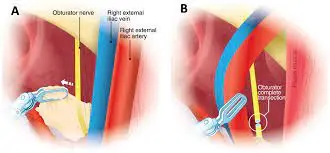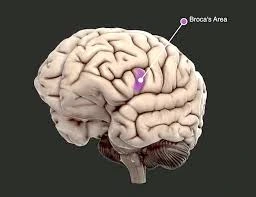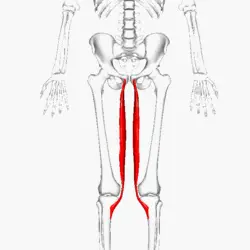Deltoid Ligament Sprain
What is a Deltoid Ligament Sprain?
A Deltoid ligament sprain refers to an injury involving the deltoid ligament, a strong, triangular band of connective tissue located on the inner (medial) side of the ankle. This ligament is essential for maintaining ankle joint stability and limiting the foot’s excessive outward movement, or eversion.
Spraining the deltoid ligament typically occurs due to trauma or excessive force applied to the ankle, often from twisting or rolling the ankle inward. Although less common than lateral ankle sprains, deltoid ligament sprains can be more severe and may involve significant pain, swelling, and difficulty bearing weight.
Causes of Deltoid Ligament Sprains:
- It is less prone to strain or tear because of its strength.
- Sudden Direction Changes: When sprinting or leaping.
- High-impact collisions, such as rugby or football tackles.
Symptoms of Deltoid Ligament Sprains:
Injuries that may progress to the heel rupture or a tearing sensation at the site of the injury, as well as pain, soreness, and swelling on the inside of the ankle.
- The inner side of the ankle pains
- swelling in the ankle’s medial region
- Getting bruised or discoloured
- The ankle joint’s instability
- Limited range of motion
Risk Factors of Deltoid Ligament Sprains:
Previous ankle sprains, sports like basketball, volleyball, or soccer, where the foot may fall awkwardly, and shoes that don’t provide enough support to stop sideways motion
Inadequate physical fitness.
Diagnosis:
However, they might also conduct imaging tests to make sure there are no bone fractures or other underlying injuries, or to learn more about the degree of your damage.
- MRI: Your doctor may utilize magnetic resonance imaging to better examine your ligament injury.
- X-ray: X-rays create images by using concentrated radiation. To look for fractures or other bone issues that could be causing your injury, your doctor can use an X-ray.
Treatment of Deltoid Ligament Sprains:
- Rest. Avoid overstressing your ankle, especially if it is causing you further pain, swelling, or discomfort.
- Ice.
- Compression. If the pain worsens, you experience numbness, or the region beneath the bandage begins to swell, loosen the wrap.
- Elevation. Elevate your wounded ankle above your heart, especially while you’re sleeping, to minimize swelling. Consider supporting it with a few cushions or pillows.
- Medicine: It could be advised to use anti-inflammatory medications like naproxen or ibuprofen.
- Use of cold and heat: Every two to three hours and after any activity that worsens symptoms, apply cold for 10 to 15 minutes. Heat should not be applied to a fresh injury, but it can be applied before stretching and strengthening exercises that your physician or personal trainer has recommended. Spend ten to fifteen minutes applying.
- Orthopedic aids: To lessen pain and swelling, apply an elastic bandage. It might be suggested to use a walking boot to support the joint. For more serious injuries, crutches may be used initially.
- Rehab and surgery: Rehab is necessary to restore ankle strength, range of motion, and balance, as well as to lower the chance of recurrent injuries.
How To Prevent Deltoid Ligament Sprains:
- To assist in preventing injuries, use braces, tape, or supportive footwear.
- Continue to work out for balance, endurance, ankle and leg flexibility, muscle strength, and overall conditioning.
- One-footed balancing exercises increase stability and reduce the risk of ankle twists.
- Wearing appropriate footwear and protective gear can help reduce unintentional injuries when participating in sports like football or soccer.
- In general, the best defense against muscle injury is to take good care of your muscles. Spend some time warming up and stretching before working out. When engaging in physical activity, avoid overtaxing your body.
- Your muscles will remain strong, flexible, and stable with training and physical conditioning, reducing your risk of injury. To give your muscles time to recover, stretch, and cool down appropriately after working out.
Complications of Deltoid Ligament Sprain:
If a deltoid ligament sprain is severe, not properly treated, or not adequately rehabilitated, complications may develop. These could include recurrent ankle pain, edema, and instability that affect everyday activities and sports performance.
Sometimes, related injuries like fractures, syndesmotic injuries, or injury to other ligaments are missed, which prolongs the healing process. Stiffness and pain may also be worsened by the development of scar tissue and restricted range of motion.
Post-traumatic arthritis in the ankle joint is also more likely to develop over time in cases of untreated or recurring sprains.
Prognosis:
The degree of the injury has a significant impact on the prognosis of a deltoid ligament sprain. Most people recover from mild to moderate sprains (Grades I or II) in a few weeks when conservative treatment is used, which includes rest, ice, compression, elevation (RICE), and physical therapy.
A lengthier recovery period and, in certain situations, surgery is frequently necessary for severe sprains (Grade III), which can involve partial or total ligament tearing. While some patients may endure lingering stiffness or a higher risk of recurrent sprains, most patients regain complete ankle function and stability with proper treatment and attention to rehabilitation programs.
Conclusion:
In summary, a deltoid ligament sprain is a serious ankle injury that has to be diagnosed as soon as possible and treated appropriately to promote the best possible recovery. The degree of the sprain and compliance with rehabilitation are important factors that affect the final result, even if conservative treatment works effectively in most instances.
Proper care, supervised physical therapy, and early intervention can encourage a return to regular activities, reduce problems, and help restore stability. People who use the proper strategy can anticipate a good prognosis and have a lower chance of long-term problems.
FAQs:
How can a damaged deltoid ligament be repaired?
Methods for deltoid repair. Either an autograft tendon, an allograft, or a suture anchor system is used in repair. An open procedure, an arthroscopic technique, or a combination technique may be used, depending on the surgeon’s skill level.
Where does a sprained deltoid ligament cause pain?
Additionally, there may be bruises, and after an accident, it’s normal for people to have trouble bearing weight on the injured ankle. This may result in a limp and trouble walking.
How do you tell if your deltoid ligament is torn?
Symptoms of a Deltoid Ligament Sprain
include experiencing a tear at the moment of harm. Your ankle is difficult to move.
How can a deltoid ligament be repaired?
In addition to autograft and allograft tendon regeneration using different procedures, deep deltoid ligament repair has been recorded employing direct end-to-end repair with sutures.
Is surgery necessary to repair the deltoid ligament?
Although deltoid repair is highly advised for complete tears, natural healing is preferred over surgery since normal fracture healing gives the deltoid ligament adequate time to recover, even if the ankle’s deltoid ligament often ruptures in a fracture.
How does one feel when their deltoid ligament is torn?
Additionally, there may be bruises, and after an accident, it’s normal for people to have trouble bearing weight on the injured ankle. This may result in a limp and trouble walking.
References
- Professional, C. C. M. (2025, March 19). Deltoid ligament. Cleveland Clinic. https://my.clevelandclinic.org/health/body/22407-deltoid-ligament
- Vallie, S. (2024, September 29). What to know about a deltoid ligament sprain. WebMD. https://www.webmd.com/first-aid/what-to-know-about-a-deltoid-ligament-sprain
- Sports Medicine: Deltoid ligament sprain. (n.d.). Nationwide Children’s Hospital. https://www.nationwidechildrens.org/conditions/sports-medicine-deltoid-ligament-sprain







